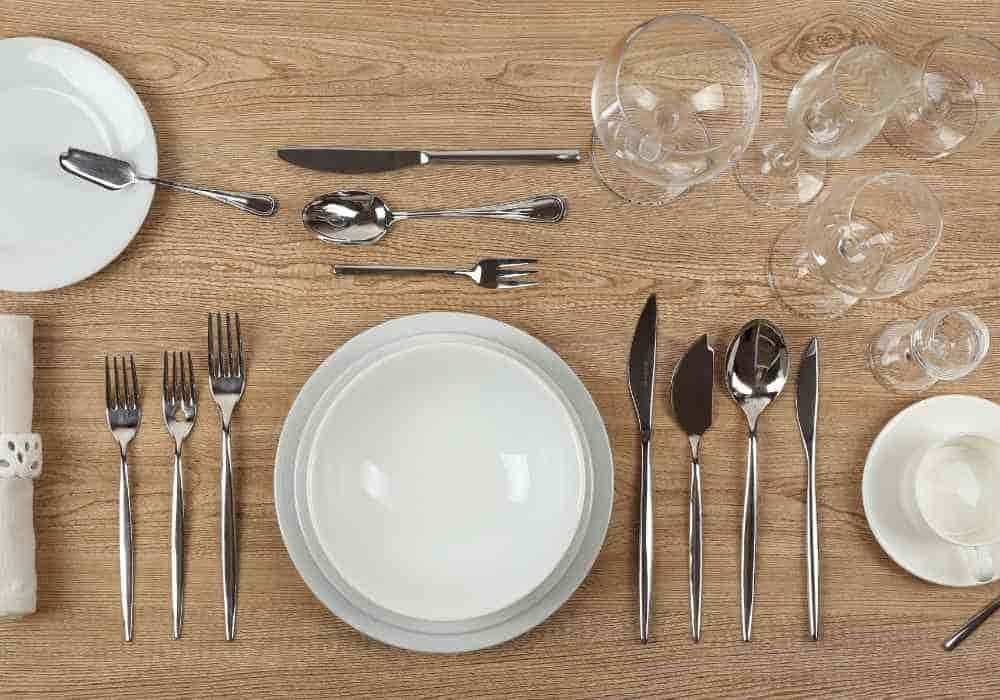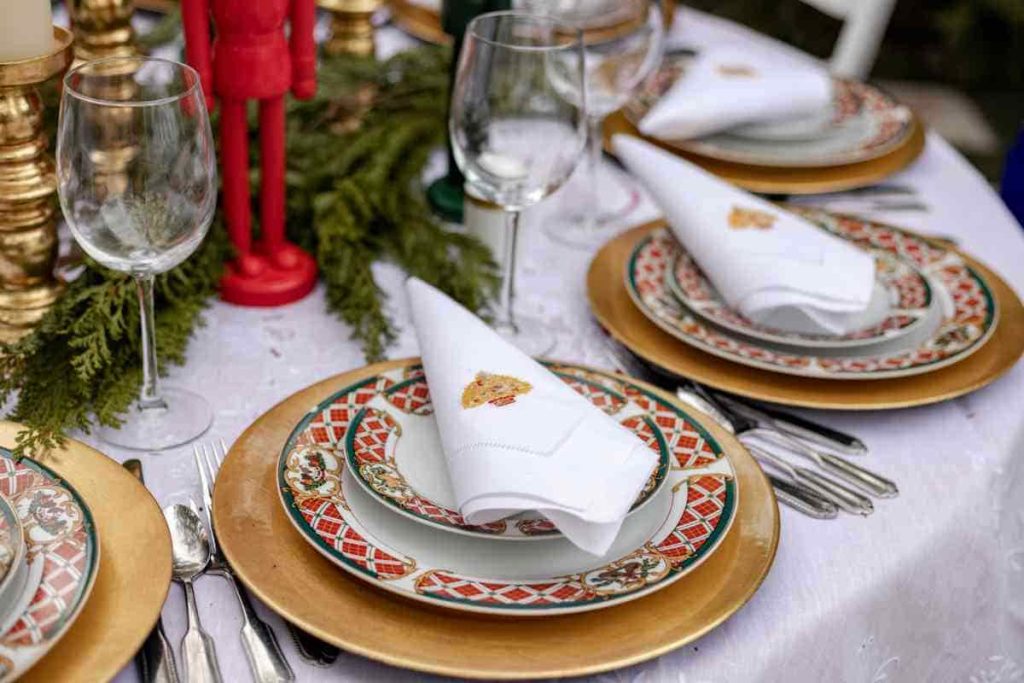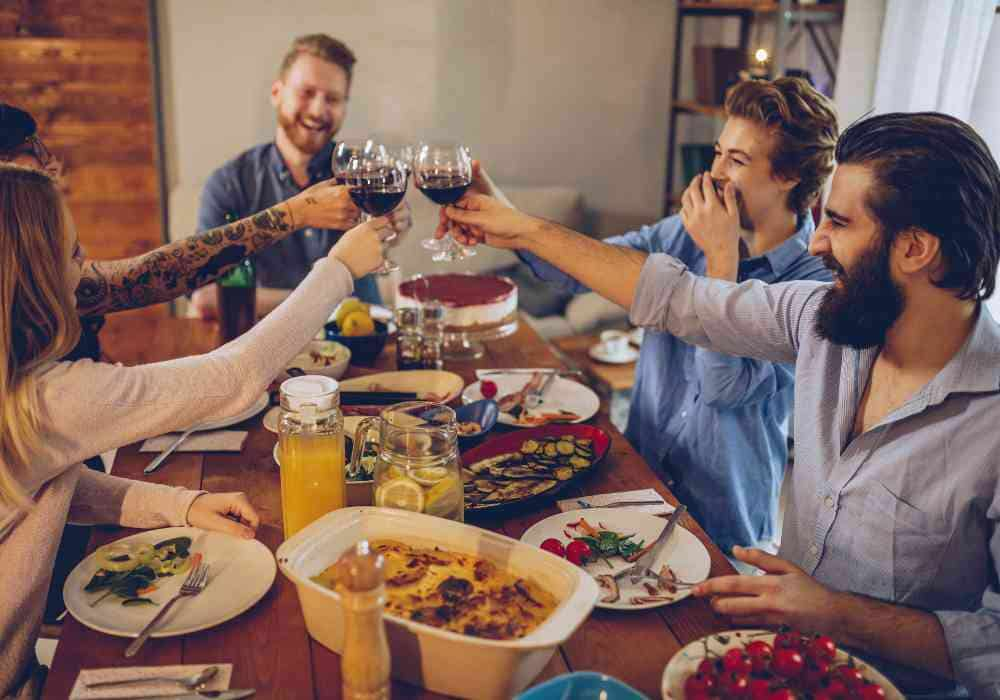An informal table setting includes a dinner plate, fork, knife, spoon, and glassware for water and wine. Tablecloths and placemats should match the theme of the event. Set a separate area for the kids to make it fun for children and adults alike.
Table of Contents
1. Table Setting Basics

The essential items for a basic table setting include a plate, a bread plate, a fork, a knife, a spoon, a water glass, and a wine glass.
Set the dinner plate at the center of each place setting for an informal dinner. If bread is part of the menu, place the bread plate to the left of the dinner plate. The fork to the left, and the knife and spoon to the right of the plate.
As for the glassware placement, the water glass goes above the knife, and the wine glass is to the right of the water goblet.
For red wine, a larger, wider glass with a rounder bowl. A smaller, narrower glass for white wine will keep the wine chilled and preserve its delicate flavors.
2. Cover Up
Tablecloths are a classic choice and can add an elegant touch to any dining room. They can also cover up any imperfections in your table and protect it from spills and scratches.
Placemats are a more casual option that can add color and texture to your table setting. They’re easy to clean and can be mixed and matched to create a unique look. But, they don’t offer as much protection to your table as a cloth.
When choosing the color and texture for your tablecloth or placemat, consider the overall theme of your dinner party. For a casual dinner party, go for a brightly colored tablecloth or mix and match different placemats.
Cotton or linen fabric would be excellent for a formal party. For placemats, you could choose anything from woven rattan to colorful paper.
3. Napkin Folding

Gone are the days of simply draping a napkin on your lap. Today, there are endless options for folding napkins that can elevate your table setting and impress your guests.
You can’t go wrong with the envelope or leaf fold for a casual dinner. The envelope fold involves folding the napkin to form a triangle. Ensure the point is at the top before folding the two bottom corners inward to meet in the middle. Fold the sides and the bottom toward the center.
Napkin colors and textures should match the occasion. You can play with bright and fun colors for informal meals or stick to earthy tones for a rustic feel. Cloth napkins in white or black are great for formal dinners.
4. Serving Utensils
Depending on the food, you may need various flatware and utensils to ensure everyone can efficiently serve themselves. Some of the most common serving utensils include:
- Serving spoons: For serving rice, mashed potatoes, and vegetables.
- Serving forks: For serving meat, such as chicken or roast beef.
- Salad tongs: If you’re serving a salad, salad tongs are a must-have.
- Ladles: If you’re serving soup or stew, a ladle helps to hold and transfer the soup.
Choose flatware that matches the dish you’re serving. If you’re serving a large pot of stew, you’ll want a larger ladle to help serve it. You should also think about the material of the utensils. Stainless steel is a popular choice as it’s durable and easy to clean.
5. Service Styles
Different occasions may call for different service styles. Let’s look at two major informal serving styles:
- Host style: In this style, the host takes care of everything, from setting the table to serving the food. It’s a relaxed and easy-going way to dine, perfect for small gatherings of friends or family.
- French style: Also known as “service à la française,” this style involves serving all courses at once and allowing guests to serve themselves from platters or bowls placed on the table. This style is often used for larger, more casual dinners
6. Getting Ready
Creating the perfect informal table setting requires preparation and attention to detail. First, ensure your table is clean and ready for guests. Wipe down the surface with a damp cloth to remove dust or debris. Set the table with appropriate linens, plates, glasses, and utensils.
It’s important to keep your guests hydrated, especially if serving alcohol. Ensure the water glasses are clean and ready to go before guests arrive.
If you plan to serve appetizers or cocktails before dinner, ensure they’re ready to go when your guests arrive. Keep the appetizers simple and easy to eat, and have a few options to cater to different tastes. As for the cocktails, prepare a signature drink that fits with the theme of the evening.
7. Seat Them Right

Where your guests sit can significantly impact the success of your dinner party. Providing some guidance on where to sit can be helpful for informal dinners with a larger group of guests. One way to do this is to place cards on the table, indicating where each guest should sit.
Consider the number of guests and the table size when choosing a seating arrangement. Several smaller tables can be arranged to encourage conversation and interaction if you have a large group of guests.
For buffet-style dinners, place the buffet in a central location and arrange tables and chairs around it to allow for easy traffic flow.
8. Kid-Friendly Dinner
If you plan on having children at a dinner party, create a separate seating area for them. This will keep them from getting restless and allow the adults to enjoy themselves without worrying about them.
Choose foods that are kid-friendly and easy to eat. Finger foods like chicken nuggets, mini-pizzas, and veggies with dip are great. As for beverages, you can’t go wrong with juices, milk, or water.
You should also have some activities planned for the children. A coloring station, board games, or a movie can entertain them.
What are the advantages and disadvantages of informal dining?
| Advantages | Disadvantages |
|---|---|
| Less pressure on the host to follow strict etiquette. | Not suitable for certain types of events, such as a black-tie affair. |
| Less expensive than a formal dinner setting. | Difficult to coordinate the meal and seating arrangements. |
| It can accommodate families with children. | It requires more effort on the part of the host to ensure guests are comfortable. |
What is the difference between formal and informal dinner?
| Informal Dinner | Formal Dinner |
|---|---|
| The dress code is formal, such as black-tie attire. | The dress code is more relaxed and casual. |
| Usually held for special occasions or events, such as weddings, charity galas, or business dinners. | Usually held for more casual events, such as family gatherings or small get-togethers. |
| Follows strict etiquette. | Less strict etiquette, with more flexibility in serving order and table manners. |
| Usually consists of multiple courses. | Typically consists of a main course. |

